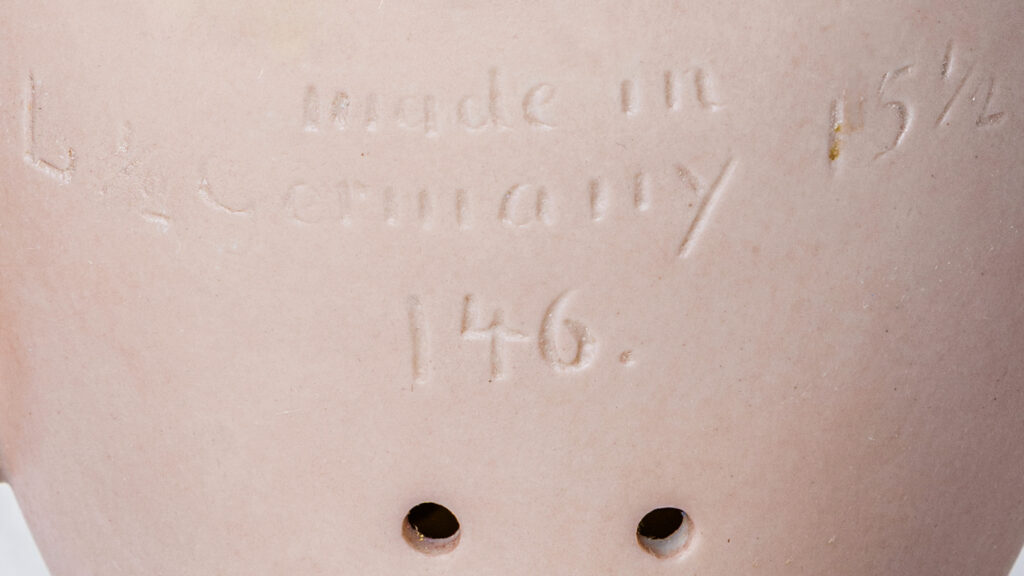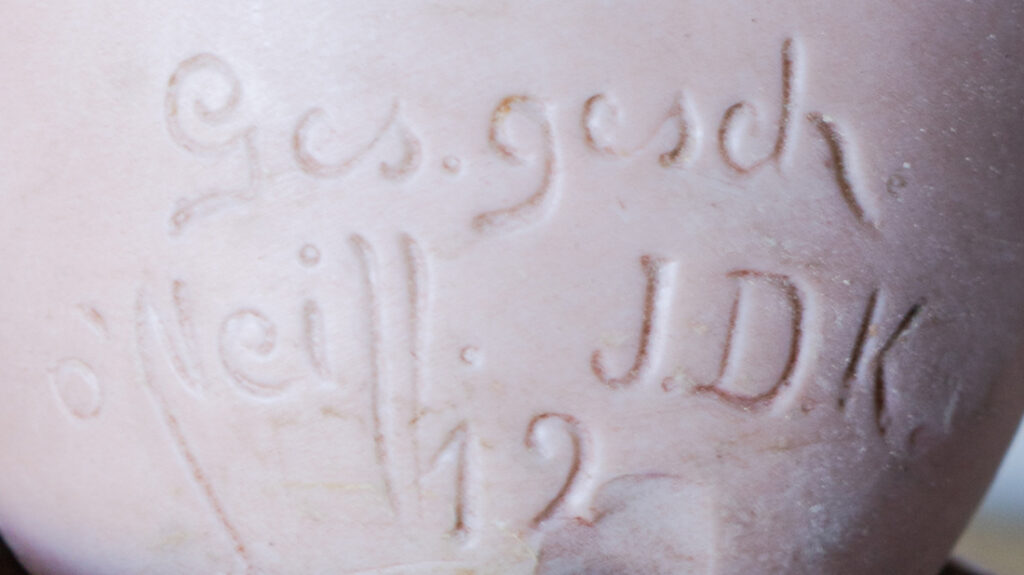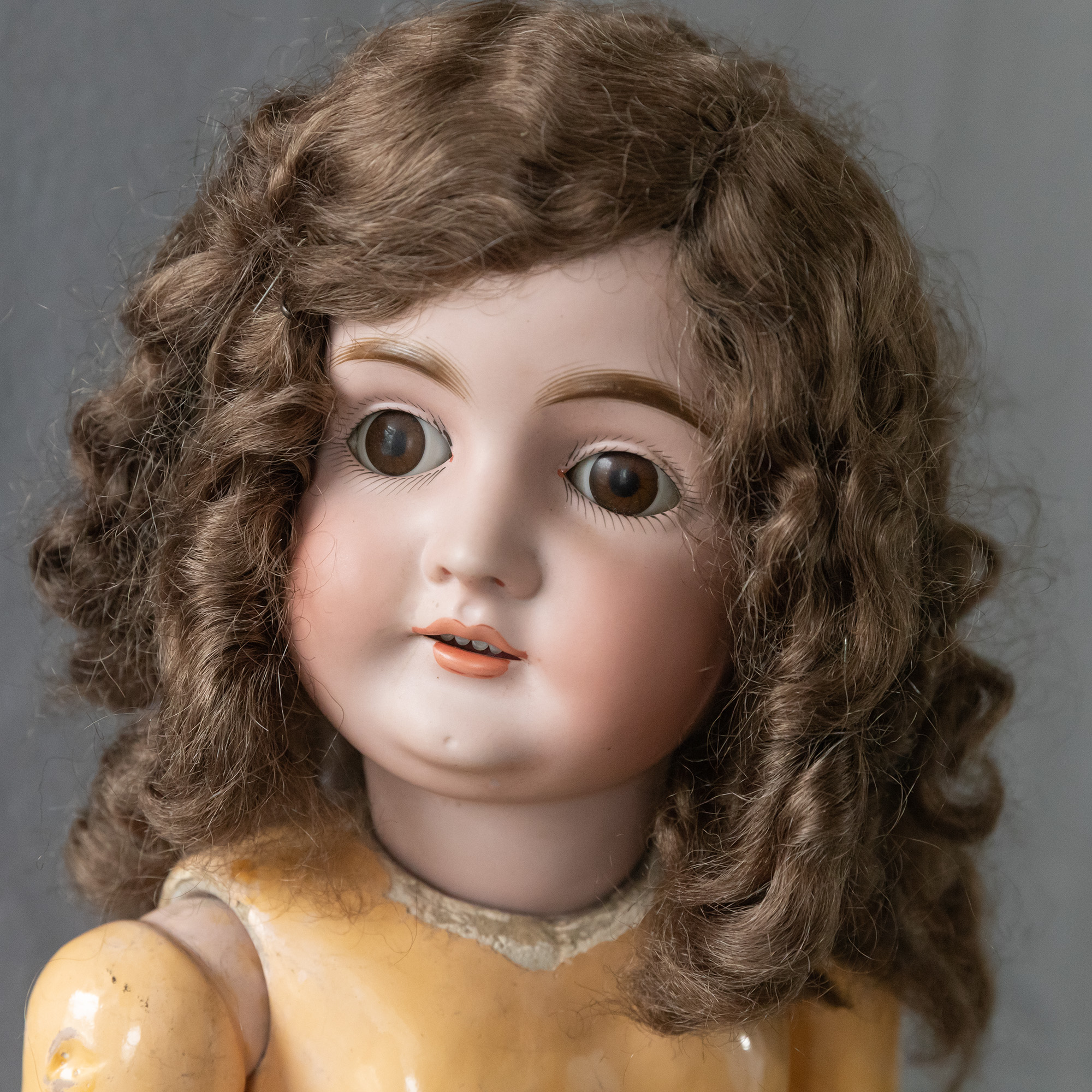When learning about dolls made by J. D. Kestner (died 1853) we must distinguish between Kestner senior who founded his sausage making business in 1805 and Kestner junior (died 1858) who founded his toy making business in 1816 (Beck, August. Geschichte des gothaischen Landes 1876.)
Yet the year of its founding is sometimes debated. The Court and State Handbook for the Duchies of Saxe-Coburg and Gotha wrote in 1901 that Kestner’s business was founded in 1815. They claimed in Germany’s official catalog for the 1893 Chicago Fair that it began in 1805, using the history of the sausage business to make the toy making business seem like it was longer in existence.
The regarding the Kestner dolls, one must distinguish between the toy and doll factory in Waltershausen and the porcelain factory in Orhdruf. Therefore the J. D. Kestner doll history may sometimes seem a bit tricky.
J. D. Kestner Sausage Business History
Johann Daniel Kestner senior or J. D. Kestner founded his sausage factory business in 1805 according to the German Addressbook of Merchants, Manufacturers and Traders. He exported to England, France, American and even Australia.
J. D. Kestner, who sold smoked meat products, (mainly Cervelatwurst), died in 1853.
The Kestner Sausage Factories in 1876
The Addressbook listed the Kestners with sausage factories in Waltershausen in a listing that gives the names of “Sausage factories: Kestner, Johann Daniel, sen. Kestner, Joh. Daniel, jun., son. Kestner, Joh. David, son. Kestner, Gottfr., Wwe. Kestner, Wilh. Aug. -Christ,Joh. Dav. – Schroder, G.”
View an ad found for Kestner Sausage published in 1883 here.
J. D. Kestner Toy Factory History
Tenneberg Castle in Waltershausen today serves as a museum that displays much of the Kestner toy making history. Mary Krombholz’s book claimed the doll museum in Waltershausen had an original catalog sample page of china or porcelain heads made in the 1840s.
J.D. Kestner junior
Kestner, Johann Daniel junior was born September 4, 1787 Waltershausen (Thuringia), and died December 11, 1858.
Manufacturing with Papier-Mâché
J. D. Kestner junior first ran a business with papier-mâché writing boards, but gradually increased and expanded the business to such an extent that his doll, toy and shirt button factory became one of the most important in Germany. Cieslik’s German Doll Encyclopedia explained that Kestner used a lathe to turn buttons and progressed to using the lathe to turn wood jointed dolls.
A Personally Written Advertisement in 1823
In Allgemeiner anzeiger und nationalzeitung der Deutschen from 1823, Kestner’s rare personally written listing advertised, “Fabricates made from papier-mâché and the like: In addition to the fabrications that I have been making for a long time, as diverse doll heads and papier-mâché figures, designs made of white leather for the doll heads, stone parchments in sheets and panels with and without holio edging, very diverse types of embroidered and looped white buttons, for shirts , chemises and women’s dresses, cardboard works, colorful paper wallets and notebooks, gold and silver, and plain paper edges and rosettes for cardboard workers, you can also always find cardboard made by me, also from my own factory, in various types at a cheap price. Waltershausen, J. D. Kestner, Jr. Owner of the factory of the above items.”
Dresses and Cufflinks
One sees mention of the manufacturing of dresses again in a listing from 1835 that advertises sewn embroidered women’s dresses and shirts. His business also manufactured cufflinks. To this business J. D. Kestner junior added the toy manufacturing.
Waltershausen Toy Factories in the 1860s
Toy factories in Waltershausen in 1864 belonged to Kestner, J. D. jun.; Hoppe & Schneegass; u. Marmorwaarenf, Wislicenus; A. Wiesenthal, Schindel, & Kallenberg; -Vey & Co; and Schuchardt, Heinr.
In 1868 the address book (Adressbuch der Kaufleute, Fabrikanten und Gewerbsleute) listed the same toy factories but -Vey & Co and Schuchardt were no longer among them. J. D. Kestner junior as having a Toy Factory in Waltershausen.
Owner: Adolph Kestner
Later in 1874 the company listing advertised J. D. Kestner Jr., Children’s Toy Factory’s founder as Joh. Dan. Kestner and Adolph Kestner as the current owner.
What to Buy and Where to Buy It
The “Handbook of European Commerce: What to buy and where to buy it; being a key to European Manufactures and Industry” published in 1876 listed J. D. Kestner among other toy manufacturers in Waltershausen.
1887 More Toy Factories in Waltershausen
The toy factory listing for Waltershausen in 1887 had expanded to include Heinrich Handwerck (specialty ball joints, baptismal candidates), Kämmer & Reinhardt, Kestner J. D. jun., Lindner Rud. Reitz Ed. & Sohn, Schneegass D. & Söhne (furniture toys and tool boxes), also export., Schuchardt H., Stange P. Wittwe (specialty fur animals), Wiesenthal, Schindel & Kallenberg, and Wislizenus A.
1893 Chicago Exposition
The French publication “Exposition de Chicago : Rapport de M. Ernest Lourdelet” from November 1893 lists Kestner of Waltershausen as a German manufacturer of pretty dolls, biscuit heads, and skin bodies.
That year Kestner junior’s toy factory listing advertised for export specializing in jointed and leather dolls, biscuit heads, bathing children etc.
The US Registered JDK Trademark

On November 10, 1896 the Firm of J. D. Kestner, Jr. registered trademark 20,129 with the United States Patent and Trademark Office for a kid body bisque head doll. The Library of Congress holds the official paper. The Kestner firm had filed the trademark a month earlier on October 10. An illustration of the registration shows a crown with the cross at the top and the banner streamers coming down with the left streamer reading “JDK.” and the right streamer reading “Germany.” The same illustration without wording represented a trademark they claimed to have used since December 24, 1895.
In 1905 one such 24 inch kid body doll cost $3.75 in the city of Los Angeles.
Photo Credit: Library of Congress
J. D. Kestner Patents
1897 Doll Patent
J.D. Kestner jr’s company Waltershausen received patent No. 35161 for a bathing child made of porcelain, with movable legs where the point of contact for the connecting element is on the contact surfaces.
During this year the company registered the famous Kestner Alphabet mold series. Doll’s with the alphabet series normally have the alphabet letter on the left and the size number on the right with the words “Made in Germany” in the middle.

The alphabet series had letters that always paired with a particular size: B 6, C 7, D 8, E 9, F 10, G 11, H 12, H¾ 12¾, J 13, J¾ 13¾, K 14, K½ 14½, L 15, L½ L½, M 16, and N 17.
In 1897 Kestner junior’s toy factory advertised toys for export listing jointed, leather, Nanking dolls, bathing children, porcelain, biscuit and wax heads, and children’s service.
1898 Doll Box Patent
Patentblatt in 1898 announced Kestner’s patent for a “cardboard box for dolls with a trough-shaped insert base and device for holding the doll.”
1901 Doll Patent
The German Patentblatt publication in 1901 listed Kestner’s patent description for a “detachable attachment of leather or material arms to leather or Zeng doll bodies, consisting of an aid for carrying out a traction device and the closed or open hooks attached to the arms. J.D. Kestner Jr., Waltershausen. 23 10 01. K. 15 233.”
1911 Bisque Head Patent
In 1911 Sprechsaal announced J. D. Kestner’s patent registration from 1910 for their bisque doll head 192 with and without glasseyes! This occurred during a period of manufacturing character dolls. (The Kestner 192 is often confused with the Kammer & Reinhardt 192 doll, but if you use the German Sprechsaal’s official announcement of Kestner 1910 registration one can consider the differences in how dolls were made during this period as the Kammer & Reinhardt 192 may not bear the word GERMANY on it and usually is found with early shoulder loose ball joints.)
And another 448,679 for a doll’s crank head with only one neck opening with glass eyes.
Orhdruf’s Kestner Porcelain Factory
The Porcelain Factory 1868
The German Addressbook of Merchants, Manufacturers and Traders listed Kestner & Co. along with Kling & Co. with porcelain factories in Ohrdruff, Germany in 1868.
1874 Joh. Dav. Kestner
In regards to the porcelain factory in Ohrdruf, an 1874 listing said, “J. D. Kestner Jr., Porcelain Factory founded in 1858 by Aug. Steuding, J. A. Müller and C. Euchler and now owned by Joh. Dav. Kestner.”
Orhdruf’s Factory Manufactured Doll Heads and More
By 1887 the porcelain factory listing for Ohrdruf specifies in parentheses doll heads, doll stands, bathing children, figures, and toys and adds Bär & Proeschild to the listing with Kling, C. F & Co.
Kestner & Co.
The porcelain factory listing claims Kestner & Co. for Ohrdruf in 1901.
Kestner & Comp. : Porcelain and Toys
The Addressbook for Ceramic Industry combines a listing for both the Kestner porcelain factory and the toy factory in the 1906 publication. The listing names Adolf Kestner in Waltershausen as owner and Commercial Councilor with Emil Krause as managing director. The listing advertises products of bath dolls, doll heads, stuffed dolls with bisque and porcelain heads, service for children, coffee, table and washing services; and kitchen sets for children in porcelain (exporting to all countries) with around 60 painters of porcelain and around 150 workers.
1914 Rose O’Neill Kewpies
In 1914 Kestner produced Kewpies for George Borgfelt & Co. One of the hardest Kewpie dolls these days to find has a bisque head with a jointed composition body jointed at shoulders, hips, and knees. The back of the bisque Kewpie head has the name Oneill for Rose O’Neill and the JDK for Kestner.
Read more about the Kewpies here.

Hilda
The same year the Kestner Kewpies came into the market, Kestner registered the patent in the U.S. for the famous HILDA baby. Hilda, a laughing sculpted doll head, showed two front teeth (September 29, 1914).
Century Doll Co.
In 1925 the Century Doll Co. of New York announced in the publication of Playthings an alliance with the firm of J. D. Kestner, Jr. and newly acquired control of the crown trade mark. Among the dolls included the well known “Sweetums” and another called “Clap Hands.”

Identifying J. D. Kestner Dolls
Kestner Dolls at the Barry Art Museum: two Gibson Girls and one Kestner fashion doll
Many Kestner bisque head dolls have very recognizable eyebrows. Earlier ones have no mold marks. China head dolls have specific facial painting features that help collectors identify them.
Bisque head dolls were normally found on composition jointed bodies made in the town of Waltershausen and usually stamped Excelsior or Germany with a read stamp on the back of the doll’s torso.

J. D. Kestner American Ads
In 1907 the Washington DC’s Evening Star published a jingle from S. Kann, Sons & Co. with the alphabet where K stood for different things one of which was “Kestner Infant Dolls.”
“There is no doll in the world with such features and curls and symmetrical lines as the Kestner dolls have.” – ad from the Omaha Daily Bee, December 1921
See other German doll markings here.
